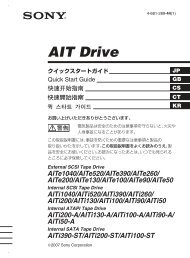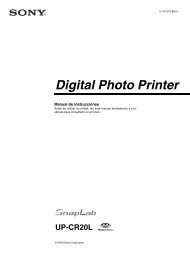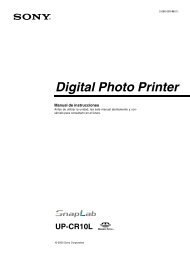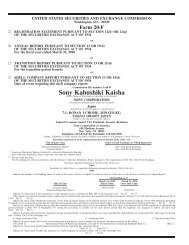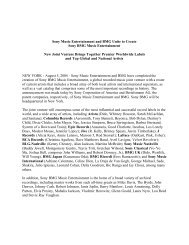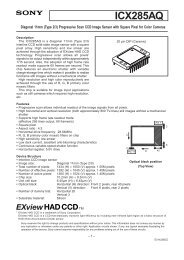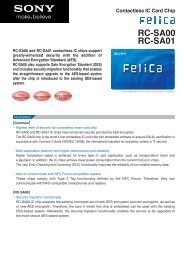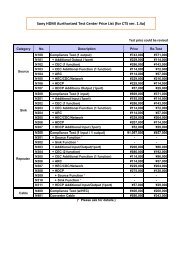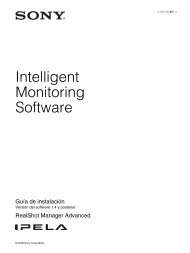PDF [4833KB] - Sony
PDF [4833KB] - Sony
PDF [4833KB] - Sony
Create successful ePaper yourself
Turn your PDF publications into a flip-book with our unique Google optimized e-Paper software.
Blue-violet laser achieves high<br />
recording density<br />
Data on an optical disc is recorded and read by<br />
passing a beam from the laser through the lens<br />
and onto a spot on the disc called the beam<br />
spot. Since blue-violet light has a shorter wavelength<br />
than red, it can produce a smaller beam<br />
spot. The result is higher recording density.<br />
Blue-violet lasers with a wavelength of 405<br />
nanometer enable Blu-ray Disc to increase<br />
recording density about 2.6 times, and combined<br />
with high-powered lenses, the recording<br />
capacity of Blu-ray Disc is six times that of the<br />
standard DVD.<br />
1.2<br />
mm<br />
DVD<br />
Comparison of beam spot size<br />
100% 19%<br />
Blu-ray Disc<br />
1.2<br />
mm<br />
High-speed data rate of 36Mbps to accommodate<br />
digital content<br />
Blu-ray Disc has a data rate of 36Mbps, much<br />
greater than the maximum speed of 24Mbps<br />
in digital HDTV from a broadcasting satellite<br />
(BS). This speed enables Blu-ray Disc to easily<br />
record digital HDTV programs from the BS and<br />
play them with remarkably high-quality picture.<br />
Blu-ray Disc recorder<br />
In April 2003, <strong>Sony</strong> unveiled the world’s first<br />
Blu-ray Disc recorder. By using the same MPEG-<br />
2TS video recording method used in BS digital<br />
TV broadcasts, this unit can record more than<br />
two hours of BS digital TV programming with<br />
no degradation in picture quality.<br />
The development of three-wavelength<br />
recording/playback optical pickups<br />
that are compatible with Blu-ray Disc,<br />
DVDs and CDs<br />
<strong>Sony</strong> has developed a three-wavelength recording/playback<br />
optical pickup that is compatible<br />
with the Blu-ray Disc, DVD and CD. In addition<br />
to reducing the number of components required<br />
and decreasing its size, <strong>Sony</strong> is striving to<br />
increase the optical pickup’s reliability and<br />
productivity, in order to rapidly commercialize<br />
this product. As the key component for the<br />
Blu-ray Disc system, this new optical pickup is<br />
positioned to contribute to the expansion of<br />
this market.<br />
Lens numerical aperture<br />
(approx. doubles density)<br />
0.6 0.85<br />
Laser wavelength<br />
(raises density approx. 2.6 times)<br />
650nm 405nm<br />
(simplified diagram)<br />
Prototype of the newly developed three-wavelength<br />
optical pickup for recording and playback<br />
0.1mm optical cover layer improves<br />
reliability<br />
On a Blu-ray Disc, data is stored at more than<br />
2.5 times the density of a DVD, while the width<br />
of the recording tracks is less than half that of a<br />
DVD. Furthermore, the tracks where the data is<br />
stored are only 0.1mm below the disc surface.<br />
Placing the recording tracks closer to the surface<br />
means that Blu-ray Discs are less prone to<br />
problems caused by disc warping and other<br />
factors compared to CDs and DVDs.<br />
Optical cover layer<br />
For 0.6mm thickness<br />
(same as in a DVD)<br />
Blu-ray Disc<br />
0.6mm<br />
Substrate<br />
NA 0.85<br />
Optical cover layer<br />
For 0.1mm thickness<br />
0.1mm<br />
Blu-ray Disc recorder<br />
Success in developing a 25GB optical<br />
disc made of paper<br />
<strong>Sony</strong> and Toppan Printing Co., Ltd., have succeeded<br />
in developing a 25GB paper optical disc<br />
with a paper content of more than 51%. Part of<br />
the disc uses paper because Blu-ray Discs can be<br />
played and recorded on the 0.1mm surface<br />
layer. The use of paper reduces the need for<br />
plastic, making the discs more environmentfriendly<br />
and decreasing manufacturing costs.<br />
A paper disc<br />
Optical pickup for conventional DVDs/CDs<br />
(top) and Blu-ray Disc (bottom)<br />
Cross-licensing agreement for optical<br />
disc-related blue-violet laser diode<br />
patents<br />
<strong>Sony</strong> and Nichia Corporation from Japan have<br />
agreed to cross-license patents involving the<br />
Blu-ray Disc format’s blue-violet laser diode. This<br />
agreement is expected to open the door to<br />
<strong>Sony</strong>’s mass-production of blue-violet laser<br />
diodes, a big step that will position it to respond<br />
to expansion in the market for Blu-ray Discformat<br />
products.<br />
Scanning electron<br />
microscope view<br />
DVD-RW<br />
Scanning electron<br />
microscope view<br />
Recording<br />
layer<br />
Optical<br />
cover layer<br />
Shortest<br />
recording mark of<br />
0.4m<br />
Track pitch of<br />
0.74m<br />
Shortest<br />
recording mark<br />
(0.16m for 23GB;<br />
0.149m for 25GB;<br />
0.138m for 27GB)<br />
Track pitch of<br />
0.32m<br />
Substrate<br />
Recording layer<br />
Optical cover layer<br />
(simplified diagram)<br />
22


![PDF [4833KB] - Sony](https://img.yumpu.com/26420643/24/500x640/pdf-4833kb-sony.jpg)

